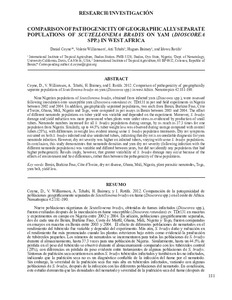| dc.contributor.author | Coyne, D.L. |
| dc.contributor.author | Williamson, V. |
| dc.contributor.author | Tchabi, A. |
| dc.contributor.author | Baimey, H. |
| dc.contributor.author | Rotifa, I. |
| dc.date.accessioned | 2019-12-04T11:08:26Z |
| dc.date.available | 2019-12-04T11:08:26Z |
| dc.date.issued | 2012 |
| dc.identifier.citation | Coyne, D., Williamson, V., Tchabi, A., Baimey, H. & Rotifa, I. (2012). Comparison of pathogenicity of geographically separate populations of Scutellonema bradys on yam (Dioscorea spp.) in West Africa. Nematropica, 42(2), 181-190. |
| dc.identifier.issn | 2220-5616 |
| dc.identifier.uri | https://hdl.handle.net/20.500.12478/1824 |
| dc.description.abstract | Nine Nigerian populations of Scutellonema bradys, obtained from infected yam (Dioscorea spp.), were assessed following inoculation onto susceptible yam (Dioscorea rotundata) cv. TDr131 in pot and field experiments in Nigeria between 2002 and 2004. In addition, geographically separated populations, two each from Benin, Burkina Faso, Côted’Ivoire, Ghana, Mali, Nigeria and Togo, were compared in pot assays in Benin between 2003 and 2004. The effect of different nematode populations on tuber yield was variable and depended on the experiment. Moreover, S. bradys damage and yield reduction was more pronounced when plants were under stress as evidenced by production of small tubers. Nematode numbers increased for all S. bradys populations during storage, by as much as 37.3 times for one population from Nigeria. Similarly, up to 44.5% tuber weight loss was observed during storage compared with control tubers (28%), with differences in weight loss evident among some S. bradys population treatments. Dry rot symptoms occurred on both S. bradys infected and also uninfected tubers, indicating that dry rot is an unreliable diagnostic for yam nematode infection. However, dry rot severity was higher on infected tubers, varying with some S. bradys populations. In conclusion, this study demonstrates that nematode densities and yam dry rot severity (following infection with the different nematode populations) was variable and differed between years, but did not identify any populations that had higher pathogenicity. Results imply, however, that greater variability of S. bradys damage may occur because of the effects of environment and host differences, rather than between the pathogenicity of these populations. |
| dc.description.sponsorship | United States Agency for International Development |
| dc.format.extent | 181-190 |
| dc.language.iso | en |
| dc.subject | Côte D'Ivoire |
| dc.subject | Dry Rot Disease |
| dc.subject | Plant Parasitic |
| dc.subject | Nematodes |
| dc.subject | Togo |
| dc.subject | Yam Belt |
| dc.subject | Yield |
| dc.subject | Scutellonema Bradys |
| dc.subject | Yams |
| dc.title | Comparison of pathogenicity of geographically separate populations of Scutelllonema bradys on yam (Dioscorea spp.) in West Africa |
| dc.type | Journal Article |
| dc.description.version | Peer Review |
| cg.contributor.crp | Roots, Tubers and Bananas |
| cg.contributor.affiliation | International Institute of Tropical Agriculture |
| cg.contributor.affiliation | University of California |
| cg.coverage.region | Africa |
| cg.coverage.region | West Africa |
| cg.coverage.country | Nigeria |
| cg.coverage.country | Ghana |
| cg.coverage.country | Benin |
| cg.isijournal | ISI Journal |
| cg.authorship.types | CGIAR and advanced research institute |
| cg.iitasubject | Yam |
| cg.iitasubject | Plant Diseases |
| cg.journal | Nematropica |
| cg.howpublished | Formally Published |
| cg.accessibilitystatus | Limited Access |
| local.dspaceid | 83276 |

